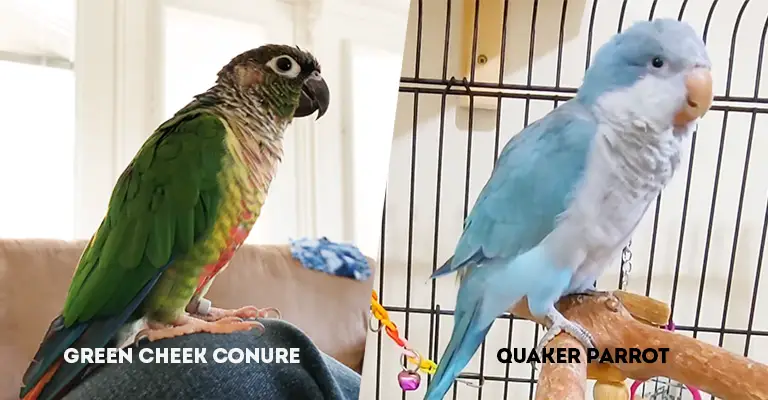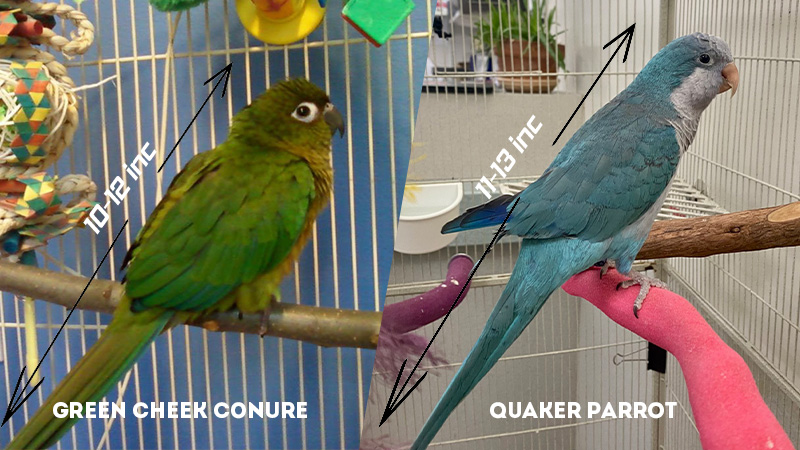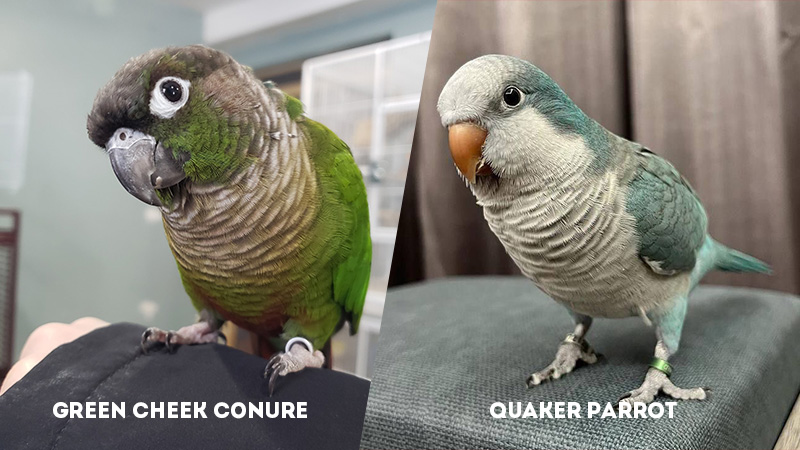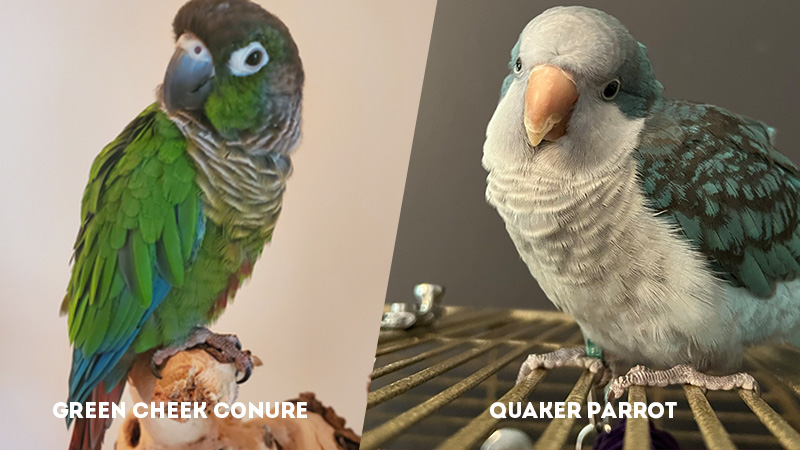Green Cheek Conures and Quaker Parrots are popular choices among bird enthusiasts seeking charming and intelligent feathered companions.
These avian species, native to the vibrant landscapes of South America, possess unique qualities that make them stand out in the world of pet birds.
From their distinct colorations and social behaviors to their individual care requirements, understanding the differences between these two species is essential for prospective owners.
In this exploration, we delve into the contrasting characteristics of Green Cheek Conures and Quaker Parrots, shedding light on their personalities, care needs, and the joys they bring to the lives of their human companions.

Key Differences Between Green Cheek Conure and Quaker Parrot
Here’s a more detailed comparison between Green Cheek Conures and Quaker Parrots:
Scientific Name
- Green Cheek Conure: The scientific name of the Green Cheek Conure is Pyrrhura molinae. It belongs to the Pyrrhura genus of parrots, which are commonly referred to as conures. This species is native to South America, mainly found in countries like Brazil, Argentina, and Bolivia.
- Quaker Parrot: The scientific name of the Quaker Parrot is Myiopsitta monachus. Also known as the Monk Parakeet, this species hails from South America as well, primarily from countries like Argentina, Brazil, and Uruguay.
Size

- Green Cheek Conure: Green Cheek Conures are generally smaller in size compared to Quaker Parrots. They measure around 10 to 12 inches in length, making them a compact and manageable choice for pet owners seeking a smaller bird.
- Quaker Parrot: Quaker Parrots are larger than Green Cheek Conures, with an average size of 11 to 13 inches. This size difference contributes to their more robust appearance compared to the conures.
Coloration
- Green Cheek Conure: One of the notable differences between these two species is their coloration.
Green Cheek Conures display a wide range of vibrant colors, including various shades of green, red, and blue on different parts of their body. Some subspecies even feature striking red tail feathers that add to their visual appeal. - Quaker Parrot: Quaker Parrots, on the other hand, are primarily known for their predominant green plumage.
They have a gray face and throat, which is a distinctive feature. While they might not exhibit the same colorful palette as Green Cheek Conures, their subtle yet charming appearance is a hallmark.
Personality
- Green Cheek Conure: Green Cheek Conures are renowned for their playful and curious personality. They are often described as cuddly and affectionate birds that enjoy interacting with their owners.
These conures tend to form strong bonds with their human companions and may even show a preference for specific individuals. - Quaker Parrot: Quaker Parrots are known for their intelligence and social nature. They have a knack for learning tricks and commands, and their energetic personality can keep owners entertained.
Quakers are social birds that often enjoy interacting with both humans and other birds, making them a lively addition to a household.
Vocalization
- Green Cheek Conure: Green Cheek Conures are generally quieter when compared to Quaker Parrots.
While they do vocalize and make sounds, their volume is usually not as loud or piercing as some other parrot species. Their sounds can include chirps, whistles, and soft squawks. - Quaker Parrot: Quaker Parrots are known for their vocal prowess. They are capable of a wide range of vocalizations, from simple chirps to complex imitations of sounds they hear in their environment.
While this can be entertaining for owners, it’s important to note that Quakers have the potential to become quite loud, especially if they are not provided with adequate mental stimulation and social interaction.
Talking Ability

- Green Cheek Conure: While Green Cheek Conures have the capacity to mimic sounds and even some words, their talking ability is somewhat limited compared to other parrot species.
They are more likely to communicate through whistles, soft sounds, and the occasional mimicry. - Quaker Parrot: Quaker Parrots are renowned for their exceptional talking ability. They have the potential to learn and imitate a wide range of sounds, words, and phrases.
With proper training and interaction, they can become quite proficient talkers, often surprising their owners with their clarity and accuracy in reproducing human speech.
Lifespan
- Green Cheek Conure: Green Cheek Conures have a relatively long lifespan compared to some other parrot species. With proper care and a healthy environment, these conures can live anywhere from 20 to 30 years, making them a long-term commitment for their owners.
- Quaker Parrot: Quaker Parrots also have a similar lifespan of around 20 to 30 years when well taken care of. Their longevity means that they can become cherished members of a family for many years, requiring a commitment to their care and well-being.
Diet

- Green Cheek Conure: Green Cheek Conures have a varied diet that includes fruits, vegetables, leafy greens, and high-quality pellets. While they enjoy the occasional treat, their diet should primarily consist of nutritious and balanced foods to ensure their health and vitality.
- Quaker Parrot: Quaker Parrots have dietary requirements that include a mix of seeds, fruits, vegetables, and pellets. Owners should ensure that their Quaker’s diet is diverse and rich in essential nutrients to prevent nutritional deficiencies and promote overall well-being.
Cage Requirements
- Green Cheek Conure: Due to their smaller size, Green Cheek Conures can be comfortably housed in relatively smaller cages compared to larger parrot species.
However, their cage should still provide ample space for movement, toys, perches, and activities to keep them mentally and physically engaged. - Quaker Parrot: Quaker Parrots are larger than Green Cheek Conures and thus require a larger cage to accommodate their size and energetic nature.
A spacious cage with horizontal bars for climbing and enough room for toys and perches is essential for ensuring their happiness and well-being.
Social Behavior
- Green Cheek Conure: Green Cheek Conures are known for their friendly and sociable nature. They often form strong bonds with their owners and enjoy spending quality time with them.
While they can be independent to some extent, they thrive on interaction and may become lonely if left alone for extended periods. - Quaker Parrot: Quaker Parrots are highly social birds that have a strong need for companionship. They form close bonds not only with their human owners but also with other Quaker Parrots.
Providing them with opportunities for interaction and play is crucial for preventing loneliness and behavioral issues.
Handling
- Green Cheek Conure: Green Cheek Conures are generally easy to handle and enjoy interacting with their owners. They are known to be relatively tame and can become quite comfortable with being held and touched.
Their smaller size makes them manageable for handling, even by those who are new to bird ownership. - Quaker Parrot: Quaker Parrots, while social and intelligent, can be more temperamental when it comes to handling. Some individuals may exhibit nippy behavior or a degree of territoriality, especially during certain times of the year.
Proper training and socialization from a young age are crucial for establishing a positive and cooperative relationship with a Quaker Parrot.
Feather Preening

- Green Cheek Conure: Green Cheek Conures are generally less prone to excessive preening compared to some other parrot species. While they do engage in regular feather maintenance, they are less likely to develop destructive preening behaviors that can lead to feather plucking.
- Quaker Parrot: Quaker Parrots have a tendency to over-preen, which can sometimes lead to feather plucking if not addressed. This behavior can be influenced by factors such as stress, boredom, or health issues.
Owners of Quaker Parrots should monitor their bird’s preening habits and provide a stimulating environment to prevent excessive preening.
Trainability
- Green Cheek Conure: Green Cheek Conures are trainable and can learn tricks, commands, and basic behaviors with patience and consistent training. They enjoy mental stimulation and can form positive associations with training sessions that involve treats and rewards.
- Quaker Parrot: Quaker Parrots are known for their quick learning abilities and can be trained to perform a wide range of tricks and behaviors.
Their intelligence and social nature make them eager participants in training sessions, which can include everything from simple commands to more complex tasks.
Compatibility
- Green Cheek Conure: Green Cheek Conures can be kept singly as long as they receive plenty of social interaction from their human caregivers. They may become strongly bonded with their owners and might not feel the need for another bird companion.
- Quaker Parrot: Quaker Parrots are highly sociable and tend to enjoy the company of both humans and other Quaker Parrots. They have a strong need for companionship and often thrive in pairs or small groups.
For those unable to provide constant interaction, having another Quaker Parrot as a companion can be beneficial for their well-being.
Cost
- Green Cheek Conure: The cost of acquiring a Green Cheek Conure is typically moderate, making them a relatively affordable option for bird enthusiasts.
However, it’s important to remember that the initial purchase cost is just one aspect of bird ownership; ongoing expenses for proper housing, food, toys, and veterinary care should also be considered. - Quaker Parrot: Quaker Parrots are also moderately priced in terms of acquisition. While their initial cost may not be exorbitant, potential owners should be prepared to invest in their long-term care, including proper housing, diet, and medical needs.
Habitat
- Green Cheek Conure: Green Cheek Conures are native to the forests and woodlands of South America, particularly regions in countries like Brazil, Argentina, and Bolivia. Their natural habitat includes lush vegetation, trees, and a variety of plants.
- Quaker Parrot: Quaker Parrots are also native to South America, primarily found in countries such as Argentina, Brazil, and Uruguay.
They are known to inhabit a range of habitats, including grasslands, forests, and urban areas, where they build their characteristic communal nests in trees and other structures.
Nesting Behavior
- Green Cheek Conure: Green Cheek Conures build their nests in tree hollows or crevices, often in the wild. In captivity, they may use nesting boxes provided by their owners to create a suitable nesting environment.
They are known for their secretive nesting behaviors and may become protective of their nesting area. - Quaker Parrot: Quaker Parrots are unique in their nesting behavior. They build large communal nests, often referred to as “apartment nests,” in trees, utility poles, or other structures.
These nests can house multiple pairs of Quaker Parrots and are constructed using twigs, branches, and other materials.
Breeding
- Green Cheek Conure: Breeding Green Cheek Conures can be a challenge, particularly for inexperienced breeders.
These birds have specific requirements for nesting conditions, temperature, and diet during the breeding season. It’s important to ensure the health and well-being of both the parent birds and their offspring. - Quaker Parrot: Breeding Quaker Parrots can be more straightforward compared to some other parrot species. They are known for their adaptability to nesting boxes and can readily reproduce in captivity.
However, providing suitable nesting materials and ensuring proper conditions are still crucial for successful breeding.
Conservation Status
- Green Cheek Conure: Depending on the specific subspecies, the conservation status of Green Cheek Conures can vary. Some subspecies are listed as “Near Threatened” due to habitat loss and fragmentation caused by deforestation in their native South American regions.
- Quaker Parrot: The Quaker Parrot, also known as the Monk Parakeet, is categorized as “Least Concern” by the IUCN Red List. This classification reflects their adaptability to a variety of habitats, including urban areas, and their stable populations.
Common Health Issues
- Green Cheek Conure: Green Cheek Conures are susceptible to various health issues, including respiratory infections, beak and feather disease, and obesity.
Maintaining a balanced diet, providing regular veterinary check-ups, and creating a clean and stress-free environment are essential for their well-being. - Quaker Parrot: Quaker Parrots are prone to health issues such as obesity and fatty liver disease due to their love for high-calorie foods.
Additionally, proper social interaction and mental stimulation are important for preventing behavioral issues that can impact their overall health.
Distinctive Traits
- Green Cheek Conure: Green Cheek Conures are known for their vibrant and varied colors, which can include shades of green, red, and blue. Some subspecies also exhibit striking red tail feathers that add to their visual appeal.
- Quaker Parrot: Quaker Parrots are recognized for their distinctive gray face and throat, contrasting with their predominantly green plumage. They also display unique head-bobbing behavior, which is a characteristic movement observed during various activities.
Green Cheek Conure Va Quaker Parrot: Comparison Table
| Aspect | Green Cheek Conure | Quaker Parrot |
|---|---|---|
| Scientific Name | Pyrrhura molinae | Myiopsitta monachus |
| Size | Smaller (10-12 inches) | Larger (11-13 inches) |
| Coloration | More vibrant, varied colors | Mainly green with gray face |
| Personality | Playful, curious, cuddly | Intelligent, social, energetic |
| Vocalization | Generally quieter | Can be noisy and loud |
| Talking Ability | Limited, some mimicry | Good mimicry, can learn words |
| Lifespan | 20-30 years | 20-30 years |
| Diet | Fruits, vegetables, pellets | Seeds, fruits, vegetables |
| Cage Requirements | Smaller cage suitable | Larger cage needed |
| Social Behavior | Friendly, can bond closely | Form strong bonds with humans |
| Handling | Generally easy to handle | May be nippy or territorial |
| Feather Preening | Less prone to excessive preening | May over-preen |
| Trainability | Can learn tricks and commands | Quick learners, can be trained |
| Compatibility | Can be kept singly | Often enjoys companionship |
| Cost | Moderately priced | Moderately priced |
| Habitat | South America | South America |
| Nesting Behavior | Limited information | Builds nest in tree cavities |
| Breeding | Difficult for beginners | Requires specific conditions |
| Conservation Status | Some species are endangered | Least Concern (common in wild) |
| Common Health Issues | Respiratory, beak issues | Obesity, fatty liver disease |
| Distinctive Traits | Red tail feathers (some subspecies) | Gray face, head bobbing |
Frequently Asked Questions
While it’s possible for Green Cheek Conures and Quaker Parrots to coexist, it’s generally recommended to house them separately. Both species have their unique social and behavioral needs, and introducing them can lead to stress, aggression, and potential health concerns. It’s safer to provide each bird with its own appropriate-sized cage and social interactions.
Yes, both Green Cheek Conures and Quaker Parrots benefit from regular grooming. This includes nail trimming and beak maintenance, as well as occasional feather clipping if necessary. Regular grooming helps prevent health issues and keeps the birds comfortable and happy.
Yes, both species can develop behavior issues if not properly managed. Green Cheek Conures may become nippy if not handled correctly, while Quaker Parrots can exhibit territorial aggression or excessive vocalization if their social and mental needs aren’t met.
It’s generally not recommended to keep Green Cheek Conures and Quaker Parrots as outdoor pets. Both species are sensitive to temperature changes, predators, and environmental stressors. They are better suited to indoor environments where temperature and safety can be controlled.
Both species can be suitable for first-time bird owners, but their needs and characteristics should be thoroughly understood before adopting. Green Cheek Conures can be a good choice due to their manageable size and friendly personality. Quaker Parrots, while intelligent and social, may require more experience and commitment due to their potential behavior challenges.
To Recap
In the dynamic world of avian companionship, the choice between Green Cheek Conures and Quaker Parrots ultimately rests on aligning with individual preferences and lifestyles.
Each species brings its own set of qualities, from the vibrant colors of the Green Cheek Conure to the sociable nature of the Quaker Parrot.
By delving into their distinctive traits, care requirements, and behavioral tendencies, potential owners can make informed decisions that lead to fulfilling and enriching relationships with these feathered friends.
Whichever path is chosen, the shared journey of companionship promises endless moments of joy, learning, and mutual companionship.
